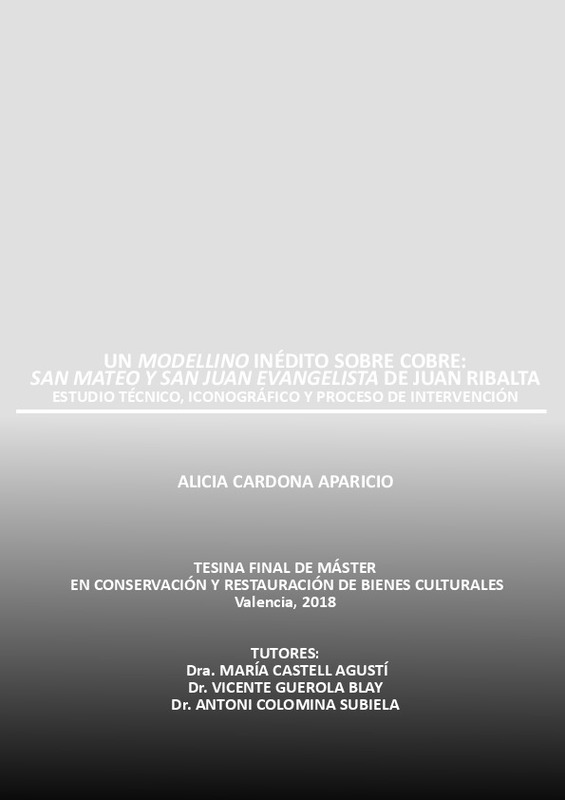|
Resumen:
|
El presente Trabajo de Final de Máster se fundamenta en el estudio de un modellino hasta la fecha inédito, atribuido a partir de nuestro trabajo al pintor Juan Ribalta (Madrid, c. 1596/1597 - Valencia, 1628).
Uno de ...[+]
El presente Trabajo de Final de Máster se fundamenta en el estudio de un modellino hasta la fecha inédito, atribuido a partir de nuestro trabajo al pintor Juan Ribalta (Madrid, c. 1596/1597 - Valencia, 1628).
Uno de los aspectos que define con mayor particularidad la presente obra, además de sus pequeñas dimensiones, radica en estar realizada con la técnica al óleo sobre una delgada lámina de cobre, una fórmula prácticamente novedosa en la Escuela Valenciana del Barroco, si bien no es el primer caso documentado de este artista. Actualmente, solo se conoce una obra de Juan Ribalta con este tipo de soporte que, bajo la representación de La Adoración de los pastores, se conserva en el Museo de Bellas Artes de Bilbao. Se trata de un trabajo autógrafo y que la crítica sitúa alrededor de 1620. Esta pintura supone una referencia y punto de partida para llevar a cabo un análisis comparativo con la obra objeto del presente estudio.
Iconográficamente, representa una escena con las figuras de san Mateo y san Juan Evangelista. Parece tratarse del estudio previo del lienzo realizado por Ribalta hacia 1625, que forma parte de la colección pictórica del Museo de Prado. Esta pintura forma pendant con el San Marcos y San Lucas, perteneciente a la misma pinacoteca, en un claro sentido de correspondencia compositiva.
El estado de conservación de la obra es bueno y no presenta ningún tipo de problema estructural. Sin embargo, manifiesta una ligera capa de barniz y suciedad superficial que conviene eliminar a través de un tratamiento de limpieza. La peculiaridad del soporte pictórico, altamente sensible a la acción oxidativa que podría provocar cualquier proceso acuoso, plantea la necesidad de proponer acciones alternativas, basadas en el uso de disolventes orgánicos y emulsiones grasas.
[-]
The present Final Master's Project is based on the study of an untold modelline, attributed from our study to the painter Juan Ribalta (Madrid, 1596/1597 - Valencia, 1628).
One of the aspects that defines the reality ...[+]
The present Final Master's Project is based on the study of an untold modelline, attributed from our study to the painter Juan Ribalta (Madrid, 1596/1597 - Valencia, 1628).
One of the aspects that defines the reality of work in greater detail, besides its small dimensions, lies in being made with the oil technique on a thin sheet of copper, a new formula in the Baroque Valencian school, although it is not the first documented case of this artist. Currently, only one work by Juan Ribalta is known with this type of support, which under the representation of The Adoration of the Shepherds is preserved in the Museum of Fine Arts in Bilbao. This is about an autograph work and its criticism is around 1620. This painting is a reference and a starting point to carry out a comparative analysis with the work object of the present study.
Iconographically, it represents a scene with the figures of san Mateo and san Juan Evangelista. It seems the case of the study of the canvas made by Ribalta towards 1625, which is part of the pictorial collection of the Museo del Prado. This painting forms pendant with San Marcos and San Lucas, belonging to the same art gallery, in a clear sense of compositional correspondence.
The conservation of the work is found in a good status and does not present any kind of structural problem. However, it shows a light coat of varnish and surface dirt that should be removed through a cleaning treatment. The peculiarity of the pictorial support, highly sensitive to the oxidative action that can affect the process, the need to propose alternative actions, based on the use of contained substances and emulsions.
[-]
|







